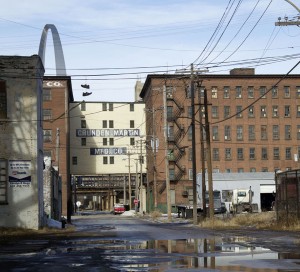by Michaela Burwell-Taylor
“The city, however, does not tell its past, but contains it like the lines of a hand, written in the corners of the streets, the gratings of the windows, the banisters of the steps…every segment marked in turn with scratches, indentations, scrolls.” – Italo Calvino

Chouteau’s Landing, a quiet industrial district south of downtown St. Louis, seems to have been frozen in time. Known to many St. Louisans as a place to park before attending a Cardinals game, this area currently contains a handful of existing businesses. This urban landscape is defined by a once thriving river industry that was the center of the St. Louis economy. A landscape of elevated railways that weave their way through the old industrial complexes and the towering concrete interstate columns, which have detached this area from the rest of the city. The original function of these buildings has long since passed, yet something remains. Something special lingers in Chouteau’s Landing and the seven historic buildings that comprise the former Crunden-Martin Manufacturing Company complex are a large part of that something.

St. Louis native Frank Crunden entered the woodenware business in 1876. Charles Martin, previously a working member of Cupples Woodenware Company, created Martin Woodenware Company in 1891. Later that year Crunden and Martin merged their Woodenware businesses creating Crunden-Martin Woodenware Company. Crunden-Martin originally occupied three small riverfront buildings that they soon out grew. The original buildings they occupied were later demolished for the Jefferson National Expansion Memorial.
The seven buildings that comprise Crunden-Martin take up a whole city block. The first building was constructed in 1904 of red brick designed by Mauran, Russell,& Garden and consisted of five stories topped with a terra cotta cornice and corbelled brick. The additional six buildings that followed were similar in design and construction, with the exception of the concrete building designed by Tom P. Barnett & Company.
Crunden, Martin, and Conzelman owned several business together; Crunden Martin Woodenware Company (later Crunden-Martin Manufacturing Company), the Conzelman-Crunden Realty Company, the Bowman Stamping Company and the Swayzee Glass Company all of which existed at one time in the seven building complex.
Between the years of 1891 and 1990 Crunden-Martin manufactured woodenware, willow wear, and metal goods. Some of the items manufactured included: buckets, ladles, bowls, baskets, ropes, brooms, axle grease, wrapping papers, toys, baby carriages, refrigerators, helmets for WWII, stoves, and other various items. In 1990 Crunden-Martin filled bankruptcy, and the buildings were sold at auction two years later. The vast amount of space that existed in these seven buildings was mainly used for storage; one building today contains a construction company.

On December 8, 2011, the westernmost building, constructed in 1912 as the fifth building in the complex, caught fire. Â The fire which appeared to have started on one of the upper floors destroyed the roof and collapsed the top two floors on the north side of the building. The cause of the fire still has not been determined. Piles of rubber gloves today can be found on the sidewalk next to building, making some contemplate what other flammable items might have been stored or left there.
Although the damage is extensive, the exterior brick walls remain unharmed, however over time the structural rigidity will be compromised due to lack of interior support. This building is connected to the adjacent building via a fourth story bridge also constructed in 1912. The loss of this building and its connecting bridge to demolition would be a devastating erasure from Chouteau’s Landing, an area with great potential for development.
The Crunden-Martin complex would not be whole without the fifth building and the street bridge that proudly states its prior owners names across it. One can only hope that whomever makes the final decision regarding this building — may it be the city, the owner, or the insurance company — decides to save this historic structure, a vital part of St. Louis riverfront history.
Michaela Burwell-Taylor was an intern at the Preservation Research Office from January 2011 through May 2012. One of her projects was documentation of the western Crunden-Martin warehouse after fire struck the building.


One reply on “Crunden-Martin After the Fire”
Lot owners, per the .
104 W. Cedar Street
Lazarus Realty Corp
3063 Thornbury
St. Louis, MO
757 S. 2nd Street
Murphy, Stephen C
190 Carondolet Plaza, Ste. 1100
St. Louis, MO 63105
100 W. Gratiot Street
Chouteau Point Realty LLC
101 Chouteau Avenue
St. Louis,MO 63102
217 Cedar Street (Powell Square)
Murphy, Stephen C
101 S. Hanley Road, Ste. 400
Clayton, MO 63105